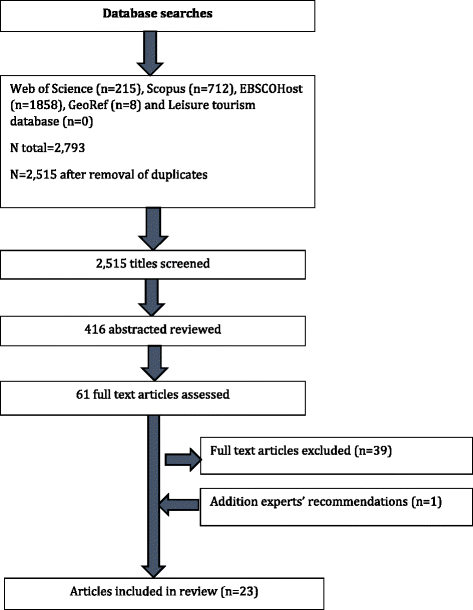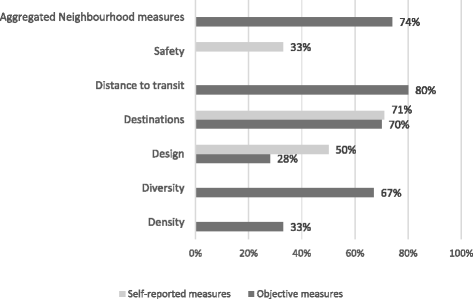The association between built environment features and physical activity in the Australian context: a synthesis of the literature
- PMID: 27277114
- PMCID: PMC4898384
- DOI: 10.1186/s12889-016-3154-2
The association between built environment features and physical activity in the Australian context: a synthesis of the literature
Abstract
Background: There is growing evidence indicating that the built environment is a determinant of physical activity. However, despite the well-established health benefits of physical activity this is rarely considered in urban planning. We summarised recent Australian evidence for the association built environment-physical activity among adults. This summary aims to inform policy makers who advocate for the consideration of health in urban planning.
Methods: A combination of built environment and physical activity terms were used to systematically identify relevant peer reviewed and grey literature.
Results: A total of 23 studies were included, providing 139 tests of associations between specific built environment features and physical activity. Of the total, 84 relationships using objective measures of built environment attributes were evaluated, whereas 55 relationships using self-reported measures were evaluated. Our results indicate that walkable neighbourhoods with a wide range of local destinations to go to, as well as a diverse use of land, encourage physical activity among their residents.
Conclusions: This research provides a summary of recent Australian evidence on built environments that are most favourable for physical activity. Features of walkability and availability of destinations within walking distance should be accounted for in the development or redevelopment of urban areas. Our findings emphasise the importance of urban planning for health via its impact on population levels of physical activity.
Keywords: Association; Australia; Built environment; Health; Physical activity; Policy; Review.
Figures
Similar articles
-
Designing healthy communities: creating evidence on metrics for built environment features associated with walkable neighbourhood activity centres.Int J Behav Nutr Phys Act. 2017 Dec 4;14(1):164. doi: 10.1186/s12966-017-0621-9. Int J Behav Nutr Phys Act. 2017. PMID: 29202849 Free PMC article.
-
Developing a research and practice tool to measure walkability: a demonstration project.Health Promot J Austr. 2014 Dec;25(3):160-6. doi: 10.1071/HE14050. Health Promot J Austr. 2014. PMID: 25481614
-
Street connectivity and walking for transport: role of neighborhood destinations.Prev Med. 2014 Sep;66:118-22. doi: 10.1016/j.ypmed.2014.06.019. Epub 2014 Jun 22. Prev Med. 2014. PMID: 24963892
-
Encouraging walking for transport and physical activity in children and adolescents: how important is the built environment?Sports Med. 2009;39(12):995-1009. doi: 10.2165/11319620-000000000-00000. Sports Med. 2009. PMID: 19902982 Review.
-
Green Streets, Healthy Hearts: Exploring the Roles of Urban Nature and Walkability in Cardiovascular Health.Methodist Debakey Cardiovasc J. 2024 Nov 5;20(5):37-46. doi: 10.14797/mdcvj.1455. eCollection 2024. Methodist Debakey Cardiovasc J. 2024. PMID: 39525385 Free PMC article. Review.
Cited by
-
Role of Environment on Physical Activity Patterns of Older Adults Living With HIV in New York City.J Assoc Nurses AIDS Care. 2023 Jan-Feb 01;34(1):31-44. doi: 10.1097/JNC.0000000000000340. Epub 2022 May 27. J Assoc Nurses AIDS Care. 2023. PMID: 35622464 Free PMC article.
-
Physical activity-related health and economic benefits of building walkable neighbourhoods: a modelled comparison between brownfield and greenfield developments.Int J Behav Nutr Phys Act. 2019 Feb 20;16(1):11. doi: 10.1186/s12966-019-0775-8. Int J Behav Nutr Phys Act. 2019. PMID: 30782142 Free PMC article.
-
Walking Behavior in Temuco, Chile: The Contribution of Built Environment and Socio-Demographic Factors.Behav Sci (Basel). 2022 May 5;12(5):133. doi: 10.3390/bs12050133. Behav Sci (Basel). 2022. PMID: 35621430 Free PMC article.
-
Walkability and its association with walking/cycling and body mass index among adults in different regions of Germany: a cross-sectional analysis of pooled data from five German cohorts.BMJ Open. 2020 Apr 28;10(4):e033941. doi: 10.1136/bmjopen-2019-033941. BMJ Open. 2020. PMID: 32350013 Free PMC article.
-
Transport-related walking among young adults: when and why?BMC Public Health. 2020 Feb 18;20(1):244. doi: 10.1186/s12889-020-8338-0. BMC Public Health. 2020. PMID: 32070313 Free PMC article.
References
-
- Bull FC, et al. Physical inactivity. Comp Quantification Health Risks. 2004;1:729–881.
-
- Australian Bureau of Statistics. Australian Health Survey: Physical Activity, 2011-12. 2015 22 Sept 2015]; Available from: http://www.abs.gov.au/ausstats/abs@.nsf/Lookup/D4495467B7F7EB01CA257BAC0....
Publication types
MeSH terms
LinkOut - more resources
Full Text Sources
Other Literature Sources
Medical



